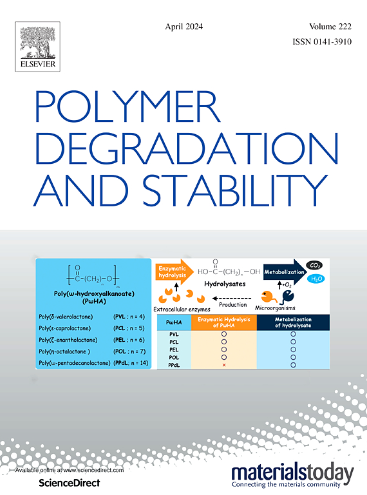Recent innovations in graphene-based nanocomposite coatings for enhanced flame retardancy in industrial applications
IF 7.4
2区 化学
Q1 POLYMER SCIENCE
引用次数: 0
Abstract
Graphene-based nanocomposite coatings have emerged as a promising solution for flame-retardant applications in industrial sectors due to their exceptional thermal stability, high surface area, and superior barrier properties. These coatings enhance fire resistance by creating protective char layers, reducing heat release rates, and limiting the spread of flames. Recent innovations focus on incorporating graphene with polymers, metal oxides, and other nanomaterials to achieve synergistic flame-retardant effects, while also improving mechanical strength, thermal conductivity, and environmental sustainability. Advanced fabrication techniques—such as solution blending, layer-by-layer (LBL) assembly, plasma-assisted deposition, and 3D printing—enable effective integration and precise control over coating structure and performance. Among these, solution blending stands out for its simplicity, scalability, and ability to ensure uniform dispersion of graphene within polymer matrices. Moreover, the integration of graphene-based coatings with smart sensing technologies allows real-time monitoring of thermal degradation, enhancing safety in critical industrial applications such as aerospace, construction, and manufacturing. This review highlights the latest advancements in graphene-enhanced flame-retardant coatings, discussing their mechanisms, fabrication strategies, and industrial potential. Future research directions should focus on cost-effective large-scale production, environmental impact assessment, and multifunctional applications to optimize fire protection in modern industries.
石墨烯基纳米复合涂层在工业应用中增强阻燃性的最新创新
石墨烯基纳米复合涂层由于其优异的热稳定性、高表面积和优异的阻隔性能,已成为工业领域阻燃应用的一种有前途的解决方案。这些涂层通过创建保护性炭层,降低热释放率和限制火焰的蔓延来增强耐火性。最近的创新集中在将石墨烯与聚合物、金属氧化物和其他纳米材料结合起来,以实现协同阻燃效果,同时提高机械强度、导热性和环境可持续性。先进的制造技术,如溶液混合、逐层组装、等离子辅助沉积和3D打印,可以有效地集成和精确控制涂层的结构和性能。其中,溶液混合以其简单、可扩展性和确保石墨烯在聚合物基体中均匀分散的能力而脱颖而出。此外,石墨烯涂层与智能传感技术的集成可以实时监测热降解,提高航空航天、建筑和制造业等关键工业应用的安全性。本文综述了石墨烯增强阻燃涂料的最新进展,讨论了其机理、制造策略和工业潜力。未来的研究方向应集中在经济高效的规模化生产、环境影响评价和多功能应用等方面,以优化现代工业的消防。
本文章由计算机程序翻译,如有差异,请以英文原文为准。
求助全文
约1分钟内获得全文
求助全文
来源期刊

Polymer Degradation and Stability
化学-高分子科学
CiteScore
10.10
自引率
10.20%
发文量
325
审稿时长
23 days
期刊介绍:
Polymer Degradation and Stability deals with the degradation reactions and their control which are a major preoccupation of practitioners of the many and diverse aspects of modern polymer technology.
Deteriorative reactions occur during processing, when polymers are subjected to heat, oxygen and mechanical stress, and during the useful life of the materials when oxygen and sunlight are the most important degradative agencies. In more specialised applications, degradation may be induced by high energy radiation, ozone, atmospheric pollutants, mechanical stress, biological action, hydrolysis and many other influences. The mechanisms of these reactions and stabilisation processes must be understood if the technology and application of polymers are to continue to advance. The reporting of investigations of this kind is therefore a major function of this journal.
However there are also new developments in polymer technology in which degradation processes find positive applications. For example, photodegradable plastics are now available, the recycling of polymeric products will become increasingly important, degradation and combustion studies are involved in the definition of the fire hazards which are associated with polymeric materials and the microelectronics industry is vitally dependent upon polymer degradation in the manufacture of its circuitry. Polymer properties may also be improved by processes like curing and grafting, the chemistry of which can be closely related to that which causes physical deterioration in other circumstances.
 求助内容:
求助内容: 应助结果提醒方式:
应助结果提醒方式:


